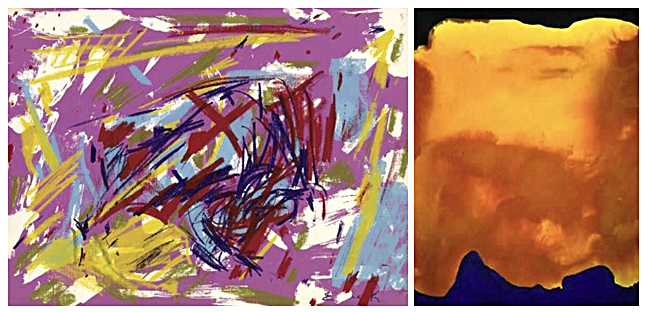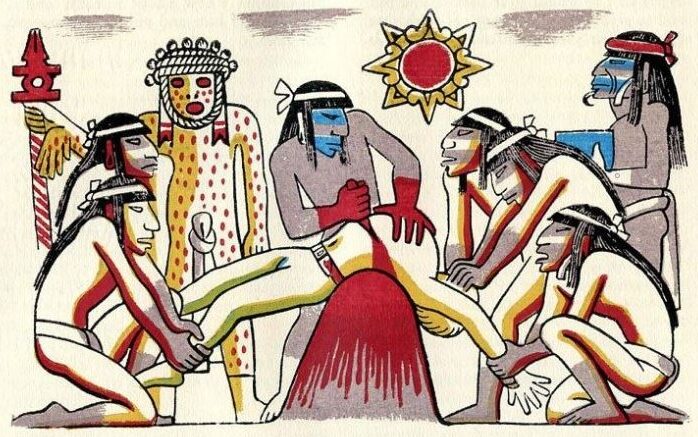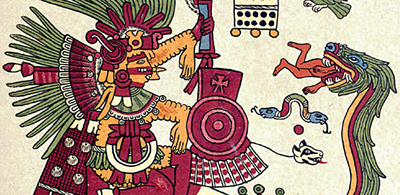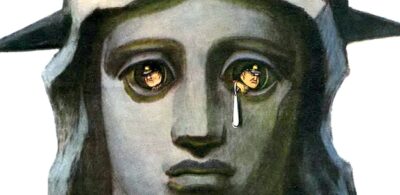Hunter Biden & the Aztecs
What new works has the eminent world renown artist Hunter Biden been working on lately? As reported by the New York Post, he has just finished “an intricately patterned painting of an Aztec god.”
When it comes to Aztec deities Hunter But didn’t pick just any old god, he went right for “the big guy.” I instantly recognized the deity in Biden’s inexpert multicolored painting as the Aztec god of war. More on that later.
First I must inform readers that Hunter will exhibit his latest works at “Bridging the Abstract,” an exhibition at the Georges Bergès Gallery in Soho, New York that opens April 6, 2023. It’s not known if Hunter’s Aztec painting will be shown.
In 2015 the “luxury lifestyle magazine” known as Resident did an interview with Bergès titled Modern Eye For Modern Art. In that interview the gallery owner heaped praise upon the wonders of Communist China:
“I want to further my embrace of the rising China and its undisputable growing influence of contemporary art and that is why my focus these days is mostly on China (…)
I have made the commitment to establish the Georges Bergès Gallery foothold in China. My plan is to be the lead guy in China; the lead collector and art dealer discovering and nurturing talent from that region. I plan to find and discover and bring to the rest of the world those I consider China’s next generation of modern artists.”
In becoming Hunter’s gallerist and promoter, Bergès has indeed wholeheartedly championed “the rising China.” For you see, Hunter has significant connections to the Red Mandarins. The Washington Post reported Hunter had dealings with CEFC China Energy—which has direct links to the Chinese Community Party (CCP). Hunter received $4.8 million from the CCP starting in 2017. But there’s nothing to worry about… I’m certain Hunter spent the money on art supplies.
But back to the “Bridging the Abstract” sideshow. Hunter’s art will be shown alongside works created by Abstract Expressionist painters Helen Frankenthaler and Elaine de Kooning. This is embarrassingly shameful.

De Kooning (1918-1989) adhered to the splash and splatter style of abstract painting. She was married to Abstract expressionist Willem de Kooning. Frankenthaler (1928-2011) worked as an abstract painter and came to advocate the “color field” school of painting; color field took abstraction to new extremes; it eliminated brushstrokes and any semblance of form in favor of simply staining large areas of canvas with pigment. The idea was to erase content altogether.
Both women were stalwart veterans of the Post WWII Abstract Expressionist movement, which unseated realism and eventually totally dominated the art world. As a realist artist I wouldn’t give you a penny for a painting from these two, and I have even less interest in the Abstract Expressionist movement as a whole.
However I will grant to De Kooning and Frankenthaler the title of nemesis, and begrudgingly acknowledge their place in art. Whereas Hunter is nothing but a crackhead who wouldn’t even have qualified to clean the paint brushes of the Abstract Expressionists. Harrumph.
But back to that Aztec god, who or what is the deity Hunter Biden painted?
The Aztec god of war was named Huitzilopochtli (wee-tsee-loh-pohch-tlee). In Nahuatl, the lingua franca of the Aztecs, the name literally means “Hummingbird Left.”
It might seem an amusing name for the Aztec’s primary deity, but if you have observed male hummingbirds defending their territory you will understand the reason. The tiny but valiant little birds will give chase to ravens and hawks; they are courageous and fearsome—just the attributes you would expect from a war god. The Aztecs worshipped all of their gods by way of ritual human sacrifice, but Hummingbird Left required more blood than most.
The Aztecs kept records of their history, exploits, and religious practices in folding accordion-like books called codices. These were created of “paper” made from fig bark or deer skin, and while the Aztecs had no formal written language, they developed a pictorial method of communication—glyphs. Today some two dozen codices have survived history. One such book is the Codex Bordonicus.

The Aztecs wrote the Codex Bordonicus just before, or right after the Spanish arrived in 1519 Mexico. It is composed of 36 folded sheets of paper emblazoned with hundreds of brightly colored glyphs that detail the cycles of their divinatory and solar calendars, religious rituals, and their gods. The codex contains a glyph of an Aztec priest dressed in the guise of Huitzilopochtli; it is the very image that crackhead Biden copied for his stupid painting.

In the Codex Bordonicus pictorial, a priest from the war god cult is shown holding the feathered shield of Huitzilopochtli in his right hand, and in his raised left hand he brandishes a lethal weapon that defeats his enemies—it is a supernatural snake of fire named Xiuhcóatl (Turquoise Serpent). Across from the priest a feathered snake—here a manifestation of Turquoise Serpent, swallows a human sacrificial victim.
The cult priest is wearing what the Aztecs called “teocuitlaquemitl” (golden clothes). A sacrificial victim’s torso and arms were skinned, and the flayed epidermis created a suit of skin; the hands were left attached to the flayed arms. By pulling on and wearing the skin suit, the cultist was transformed into the war god he worshiped. The golden clothes are plainly seen in the glyph.

It is highly unlikely that a dullard like Hunter Biden is aware of anything I have described above. In all probability, by the looks of his silly artwork, he simply noted the Aztec graphic somewhere and thought it would make a “cool” painting.
Liberals and leftists usually go to pieces when confronted with examples of people using the cultural identity of others for their own profit. But something tells me there will be no protests regarding Hunter’s “cultural appropriation.”
The last great art critic Robert Hughes (1938-2012) pilloried the contemporary art world in his 2008 documentary, The Mona Lisa Curse. In the film Hughes noted: “Apart from drugs, art is the biggest unregulated market in the world, with contemporary art sales estimated at around $18 billion a year.”
It’s no secret the art world has become an environ where elites indulge in money laundering. For heaven’s sake, even CNN wrote a 2020 article titled “The art world has a money laundering problem.” Naturally it focused on two Russian oligarchs who “allegedly seized on the secrecy of the art industry to evade sanctions.” In 2021 the New York Times published As Money Launderers Buy Dalís, U.S. Looks at Lifting the Veil on Art Sales, a weak article that mentioned Russians and drug dealers, but little else.
There’s no doubt CNN and the New York Times won’t be… excuse me, “sniffing” around the Bidens when it comes to art and money laundering. But that’s not really surprising. It’s also not shocking that Hunter Biden’s mediocre Aztec war god painting is being displayed in an art exhibition.
Art as sacrificial victim. Oh those golden clothes!




